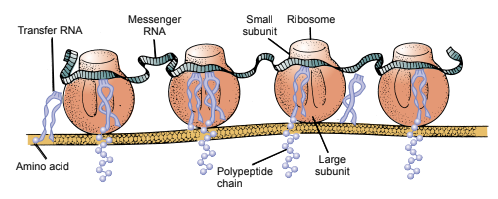Makindo Medical Notes"One small step for man, one large step for Makindo" |
|
|---|---|
| Download all this content in the Apps now Android App and Apple iPhone/Pad App | |
| MEDICAL DISCLAIMER: The contents are under continuing development and improvements and despite all efforts may contain errors of omission or fact. This is not to be used for the assessment, diagnosis, or management of patients. It should not be regarded as medical advice by healthcare workers or laypeople. It is for educational purposes only. Please adhere to your local protocols. Use the BNF for drug information. If you are unwell please seek urgent healthcare advice. If you do not accept this then please do not use the website. Makindo Ltd. |
Ribosomes
-
| About | Anaesthetics and Critical Care | Anatomy | Biochemistry | Cardiology | Clinical Cases | CompSci | Crib | Dermatology | Differentials | Drugs | ENT | Electrocardiogram | Embryology | Emergency Medicine | Endocrinology | Ethics | Foundation Doctors | Gastroenterology | General Information | General Practice | Genetics | Geriatric Medicine | Guidelines | Haematology | Hepatology | Immunology | Infectious Diseases | Infographic | Investigations | Lists | Microbiology | Miscellaneous | Nephrology | Neuroanatomy | Neurology | Nutrition | OSCE | Obstetrics Gynaecology | Oncology | Ophthalmology | Oral Medicine and Dentistry | Paediatrics | Palliative | Pathology | Pharmacology | Physiology | Procedures | Psychiatry | Radiology | Respiratory | Resuscitation | Rheumatology | Statistics and Research | Stroke | Surgery | Toxicology | Trauma and Orthopaedics | Twitter | Urology
Related Subjects: |DNA replication |The Nucleus |Mitosis and Meiosis |Ribosomes |Microtubules |Mitochondria |Smooth and Rough Endoplasmic Reticulum |Sodium Potassium ATPase pump |The Cell membrane
Ribosomes are complex molecular machines found within all living cells that perform the critical function of protein synthesis. They translate genetic information encoded in messenger RNA (mRNA) into polypeptide chains, which fold into functional proteins. Ribosomes can be found floating freely in the cytoplasm or attached to the endoplasmic reticulum, forming the rough ER.

Structure of Ribosomes
- Subunits :
- Ribosomes are composed of two subunits: a large subunit and a small subunit.
- In prokaryotes, the ribosome is 70S, consisting of a 50S large subunit and a 30S small subunit.
- In eukaryotes, the ribosome is 80S, consisting of a 60S large subunit and a 40S small subunit.
- RNA and Proteins :
- Ribosomes are composed of ribosomal RNA (rRNA) and ribosomal proteins.
- rRNA forms the structural and functional core of the ribosome, while proteins provide structural support and enhance function.
Function of Ribosomes
- Protein Synthesis :
- Ribosomes translate mRNA into polypeptide chains by reading the sequence of codons in the mRNA.
- tRNA molecules, each carrying a specific amino acid, bind to complementary codons on the mRNA, facilitating the assembly of amino acids into a polypeptide chain.
Stages of Protein Synthesis
- Initiation :
- The small ribosomal subunit binds to the mRNA near the 5' cap and scans for the start codon (AUG).
- The initiator tRNA, carrying methionine, binds to the start codon.
- The large ribosomal subunit joins to form the complete ribosome, positioning the initiator tRNA in the P site.
- Elongation :
- Aminoacyl-tRNA, carrying the appropriate amino acid, enters the A site of the ribosome.
- A peptide bond forms between the amino acid in the A site and the growing polypeptide chain in the P site.
- The ribosome moves along the mRNA, shifting the tRNA from the A site to the P site, and the empty tRNA exits from the E site.
- This process repeats, adding amino acids to the growing polypeptide chain.
- Termination :
- Translation continues until the ribosome encounters a stop codon (UAA, UAG, UGA) on the mRNA.
- Release factors bind to the stop codon, prompting the release of the polypeptide chain from the ribosome.
- The ribosome dissociates into its subunits, releasing the mRNA and tRNA.
Types of Ribosomes
- Free Ribosomes :
- Located in the cytoplasm and synthesize proteins that function within the cytosol.
- Bound Ribosomes :
- Attached to the endoplasmic reticulum, forming the rough ER.
- Synthesize proteins destined for secretion, incorporation into the cell membrane, or inclusion in lysosomes.
Clinical Relevance
- Antibiotics Targeting Ribosomes :
- Many antibiotics inhibit bacterial protein synthesis by targeting the prokaryotic ribosome, exploiting differences between prokaryotic and eukaryotic ribosomes.
- Examples include tetracyclines, which block the A site, and macrolides, which inhibit translocation.
- Ribosomal Disorders :
- Mutations in ribosomal proteins or rRNA can lead to ribosomopathies, diseases characterized by defects in ribosome function.
- Examples include Diamond-Blackfan anaemia and Treacher Collins syndrome.
- Cancer :
- Dysregulation of ribosome biogenesis and function is often observed in cancer cells, contributing to uncontrolled cell growth and proliferation.
Research and Therapeutic Approaches
- Ribosome Engineering :
- Genetic engineering of ribosomes to enhance their function or to incorporate non-natural amino acids into proteins for therapeutic purposes.
- Targeted Therapies :
- Development of drugs that specifically target ribosomal function in cancer cells or pathogens without affecting normal cells.
Summary
Ribosomes are essential cellular organelles responsible for translating genetic information from mRNA into proteins. They consist of two subunits, composed of rRNA and proteins, and can be found either freely in the cytoplasm or attached to the rough endoplasmic reticulum. Ribosomes play a critical role in protein synthesis, with implications for antibiotics, genetic disorders, and cancer. Advances in ribosome research hold promise for novel therapeutic approaches and a deeper understanding of cellular function.